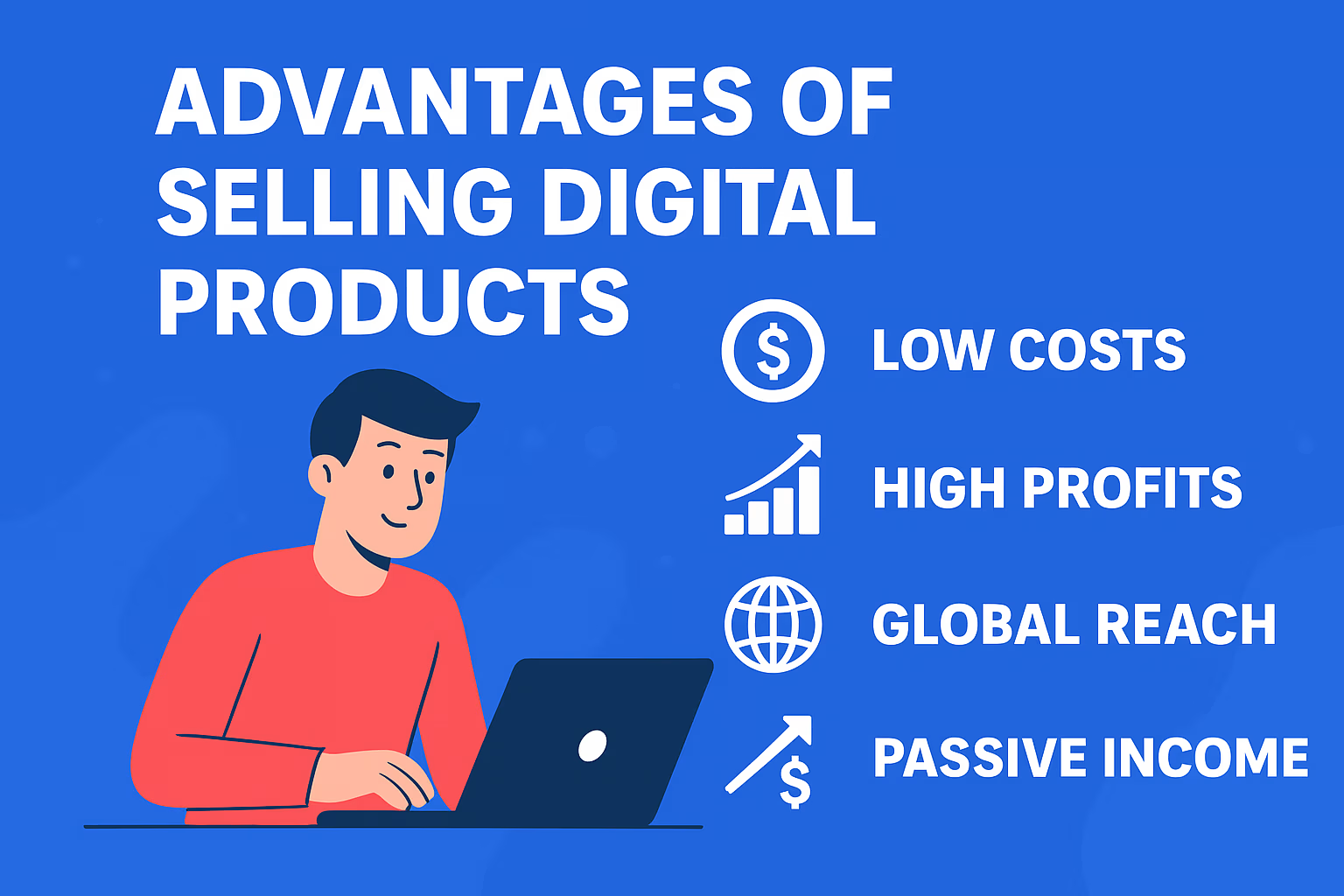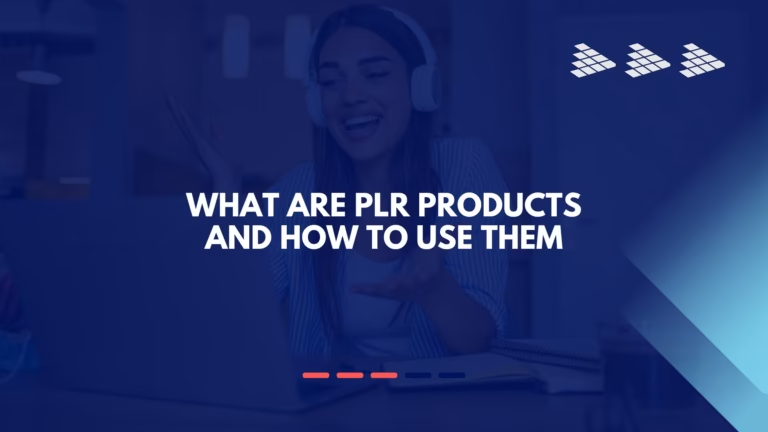Benefits of Selling Digital Products
Abstract
The international digital economy has expanded exponentially, unprecedentedly creating chances for individuals and businesses to make profits from creativity, technical skills, and knowledge. Among these possibilities, digital product selling is a high-margin, scalable, and low-barrier-to-entry business model. This report examines the advantages of selling digital products, computes market statistics, provides revenue potential statistical analysis, and forecasts monthly income scenarios. The findings are that the sale of digital products has its own competitive advantages in scalability, cost savings, and profitability compared to physical products.
________________________________________
Introduction
Digital products are intangible resources that are electronically transmitted and include ebooks, templates, online courses, software, plugins, stock media, and membership content. Digital products require no manufacturing, warehousing, or shipping, as opposed to physical products, and thus are highly cost-effective to produce and distribute.
As per Mordor Intelligence (2025), the international digital goods market is worth $124.3 billion in 2025 and is anticipated to expand to $416.2 billion by 2030 with a compound annual growth rate (CAGR) of 27%. Likewise, the e-learning market — among the biggest segments of digital products — is anticipated to hit $400–600 billion across the globe in the same period (Grand View Research, 2024). These figures depict the fiscal significance of online products and why more businesspeople attempt this business model.
This study explores the advantages of marketing online products supported by facts, market research, and mathematical models of profit.
________________________________________
Advantages of Selling Online Products
1. Cost Efficiency and Wide Margins
One of the most influential advantages of selling digital products is the near zero marginal cost. After the production of the initial product, the cost of duplication is virtually nothing.
• Gross margins of companies selling digital products are between 70% and 97%, while that of companies selling physical goods is at an average of 30%–50% (StarterStory, 2024).
• Startup costs for most digital entrepreneurs are less than $100, utilizing software such as Canva, WordPress, and Gumroad.
Such cost-effectiveness makes digital products a feasible option for single entrepreneurs and small businesses seeking profitability without investing heavy capital. ______________________________________
2. Scalability and Automation
Unlike physical goods firms requiring proportional resources for growth, digital products allow non-linear growth.
•\tOne product can be delivered globally, 24/7, without additional labor.
•\tMarketing and distribution can be automated through email sequences, internet funnels, and subscription models.
This scalability makes it possible for a creator to sell to 100 customers or 100,000 customers with very little in the way of structural changes, one of the shiniest advantages of selling digital products.
____________________________________
3. Global Reach and Access
Digital products are not geographically bounded. A course created in Bangladesh can be purchased instantly in Los Angeles, London, or Tokyo.
•\tIt has been found that 80% of consumers purchase digital content from worldwide providers at least once a year (Statista, 2024).
•\tPlatforms like Gumroad, Etsy (digital products section), and ThemeForest offer exposure to millions of customers globally.
This global reach opens market opportunities beyond local boundaries.
________________________________________
4. Business Model Flexibility
Digital products enable several monetization models, which brings stability to revenue streams. Some examples are:
•\tSingle-payment sales (ebooks, templates, plugins).
•\tSubscription-based models (premium content, design collections).
•\tTiered and bundle pricing (basic vs. premium offerings).
•\tLicensing and white-labeling rights (reselling rights, PLR/MRR models).
This flexibility allows entrepreneurs to move quickly to respond to market demand and earn maximum revenue.
______________________________________
5. Speed of Creation and Iteration
Creating a physical product takes months. A digital product can be taken to market in weeks — or even days — depending on complexity.
• Content creators can get an ebook or template set out in under 30 days.
• Software coders can ship a “minimum viable product” (MVP) and iterate based on what they hear back.
Rapid iteration minimizes risk and enables faster revenue realization, a fundamental benefit for lean startups.
____________________________________
6. Evergreen Income Potential
Since digital products don’t need inventory and little maintenance, they can provide passive or semi-passive income.
•\tEvergreen templates and courses continue selling years down the road.
•\tAutomatic funnels can maintain sales without every-day manual operation.
This provides selling digital products as a compelling choice for people looking for side hustles or diversified income streams.
____________________________________
Statistical Analysis: Market Income and Reality Check
While the advantages of digital goods sales are apparent, income levels vary considerably among creators. A benchmark report of the creator economy found:
•48% of creators earn less than $15,000 annually, suggesting hobby or part-time work (Influencer Marketing Hub, 2024).
•22% earn $50,000–$100,000 annually, typically full-time digital entrepreneurs.
• Smaller niches command six- or seven-figure annual revenues, typically by establishing solid personal brands or marketing systems.
This split illustrates that profitability is attainable but comes about through dogged work in audience development, product quality, and marketing strategy.
________________________________________
Earnings Potential: Monthly Revenue Models
To illustrate earnings potential, below are four modeled scenarios with conservative to aggressive assumptions. These models demonstrate how traffic, conversion rates, and product prices interact to produce revenue.
________________________________________
Scenario A: Hobby Seller
• Visitors: 1,000/month
• Conversion Rate: 1% → 10 sales
• Average Price: $15
• Revenue: $150
• Profit (90% margin): $135/month
________________________________________
Scenario B: Part-Time Seller
• Visitors: 10,000/month
• Conversion Rate: 2% → 200 sales
• Average Price: $29
• Revenue: $5,800
• Profit (85% margin): $4,930/month
________________________________________
Scenario C: Full-Time Creator
• Visitors: 50,000/month
• Conversion Rate: 2.5% → 1,250 sales
• Average Price: $49
• Revenue: $61,250
•Profit (90% margin): $55,125/month
________________________________________
Scenario D: Scaled Business
• Visitors: 200,000/month
• Conversion Rate: 3% → 6,000 sales
• Average Price: $79
• Revenue: $474,000
• Profit (90% margin): $426,600/month
________________________________________
Interpretation of Earnings Models
• Scenario A presents side-hustle potential, perfect for beginners.
• Scenario B demonstrates the earnings level where most creators transition to part-time or supplement income.
• Scenarios C and D demonstrate the scalability of digital products supported by massive audiences and strong marketing infrastructure.
These models confirm that among the greatest advantages of selling digital products is the potential to grow income without accompanying rises in cost.
________________________________________
Risks and Challenges
While there are many advantages, there are also issues that need to be addressed by sellers:
• Market saturation: Markets such as plain templates or pre-designed assets are very competitive.
• Platform dependency: Relying on marketplaces makes the seller susceptible to price increases or policy changes.
• Marketing necessity: Quality of the product is not sufficient; there must be ongoing traffic generation.
Combating these issues requires differentiation, establishing owned distribution channels (e.g., e-mail lists), and applying elastic business strategies.
________________________________________
Conclusion
This research demonstrates that the advantages of marketing digital goods are immense and economically desirable. The model offers:
- •\tLow marginal costs that are cost-effective.
- •\tScalability and automation with no linear growth in resources.
- •\tAccess globally, creating access to global consumers.
- •\tHigh profitability, with margins of 70%–90% or higher.
- •\tFreedom to monetize in the form of subscription and licensing.
- •\tSustainable earning capacity, ranging from side-hustle earnings to multi-six-figure monthly revenues.
While fraught with peril on occasion, the statistical information indicates that selling digital products represents one of the superior entrepreneurial ventures currently found in the new economy. For creators, educators, and entrepreneurs, the advantages compensate for the hassles, and digital products form a bedrock of the new digital economy.
- Get Unlimited High Quality PLR Digital Products for your growing empire.
- MRR Products
- PLR eBooks
- PLR/MRR video courses
- Website Templates
- AI Prompts
- Done For You Courses
________________________________________
References (APA Style)
- Grand View Research. (2024). E-learning market size, share & trends analysis report. Retrieved from https://www.grandviewresearch.com
- Mordor Intelligence. (2025). Digital goods market report (2025–2030). Retrieved from https://www.mordorintelligence.com/
- StarterStory. (2024). How profitable are digital products? Retrieved from https://www.starterstory.com/
- Statista. (2024). Digital media and content consumption statistics. Retrieved from https://www.statista.com/
FAQ
1. What are the main advantages of selling digital products?
The biggest advantages include:
Low costs (you only create once).
High profit margins (70%–97%).
Scalability (sell to thousands without extra effort).
Global reach (customers from anywhere).
Passive income (earn long-term after setup).
2. How much can I earn from digital products per month?
Earnings vary depending on effort, product quality, and audience size.
Beginners may earn $100–$500/month.
Part-time sellers often reach $2,000–$5,000/month.
Full-time businesses with large traffic can make $10,000+ per month.
3. What are some popular digital products to sell?
Ebooks and guides
Online courses
Templates (websites, resumes, business forms)
Stock photos, graphics, and music
Software, apps, or plugins
Memberships and subscriptions
4. Do I need a lot of money to start selling digital products?
No. Many people start with under $100 using tools like Canva, WordPress, or Gumroad. The main investment is time and creativity.
5. Is selling digital products passive income?
Yes, but not at the beginning. You need to create the product and set up marketing first. Once automated, sales can happen without you being online, making it a source of semi-passive income.
6. Are there risks in selling digital products?
Yes. The main risks are:
Competition in popular niches.
Dependence on third-party platforms (like Etsy or Amazon).
Piracy or unauthorized sharing of your product.
However, with branding, email lists, and unique products, most sellers overcome these risks.
7. Do I need to be a tech expert to sell digital products?
Not necessarily. Many platforms make it easy. For example:
Gumroad, Etsy, and Payhip let you upload and sell instantly.
WordPress or Shopify can give you more control with a bit of learning.
8. Can selling digital products be a full-time business?
Yes. Many creators run full-time businesses with digital products, especially with online courses, memberships, or software. With consistent marketing and growth, it can replace or exceed a traditional job.







